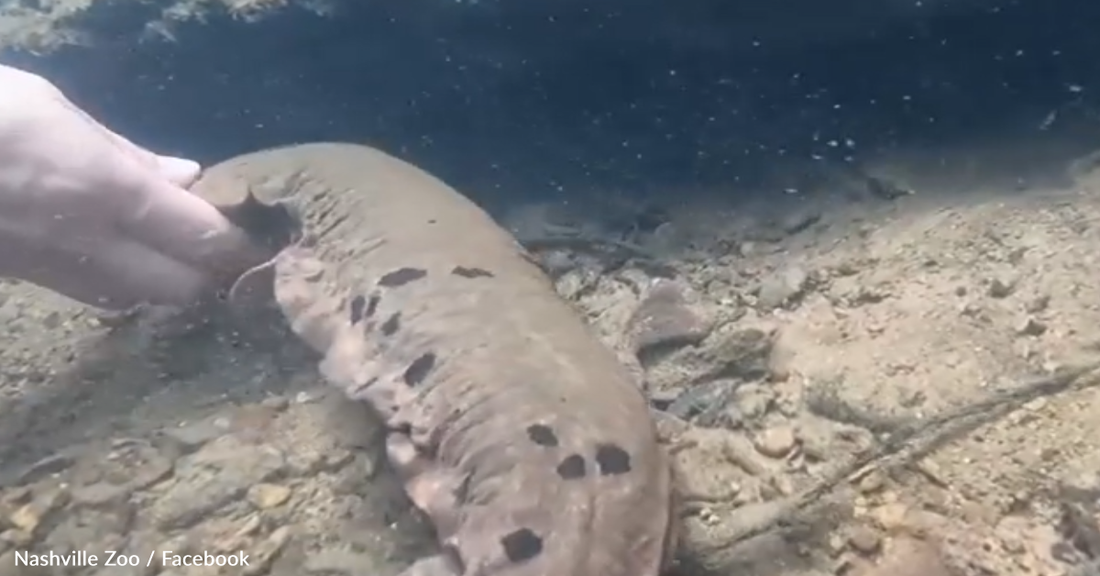How Scientists Are Fighting To Save America's Largest Salamander
Timothy Roberts
In the United States, there are seven families of salamanders that live in various areas. They tend to be hidden from sight, as they are nocturnal. There are some, however, that are now becoming more visible, thanks to the efforts of scientists.
This is seen in Tennessee, as scientists are busy trying to repopulate the Eastern Hellbender. They are doing so by releasing the native salamanders into the environment, and they are also tracking them by means of an implanted transmitter.
According to the Virginia Department of Wildlife Resources, Hellbender salamanders were once relatively common. They are the largest salamander in North America, but these days, they are having a difficult time.
Eastern Hellbenders should not be mistaken with Ozark hellbenders, which are doing well. The eastern variety is struggling to survive, even though they had not yet been listed as federally endangered.
The amphibian and reptile keeper at the national zoo, Sherri Doro Reinsch, is working hard to ensure they don't disappear from the scene altogether. She is working along with the Tennessee Wildlife Resources Agency and Tennessee State University. They have a program in place where they raise salamanders from eggs and release them to the wild when they get old enough.
According to Smithsonian’s National Zoo & Conservation Biology Institute, the female hellbender can lay up to 500 eggs at a single time. Once they hatch, the father, or denmaster, takes care of the young for the first year. At that time, they live in the riverbed gravel and eat insect larvae. Eventually, they become the adult hellbenders that are better known.
The problem is, most of the hellbenders are not surviving the early stages until they have the time to change into adults. According to the Natural Resources Research Institute, since the 1980s, when the population first started dropping, they have lost about 80% of the population in the wild.
It isn't clear why hellbenders are disappearing from the wild but what is known is that the numbers are declining. Scientists are having a difficult time finding nests, so it's challenging to make the determination of what is causing the problem.
According to FOX 17 News, eleven hellbender scientists are working hard in the program, which started in 2015. The salamanders being released at this time are part of eggs captured in central Tennessee. They take part of the clutch from the local waterway and then raise them to the point where they can survive in the wild.
Scientists continue caring for the hellbenders in the zoo environment and preparing them for life in the wild, according to a press release from the Nashville Zoo. They have not released the location where they are being released to help protect them.
Nobody knows exactly how long the salamanders can live, but they live up to 30 years in captivity. It may be possible for them to live 50 years or longer in the wild.
 Photo: Facebook/Nashville Zoo
Photo: Facebook/Nashville Zoo
The fact that hellbender salamanders are disappearing may be a problem for humans. Since they need clean water to survive, the fact that they are disappearing may speak poorly about the quality of the water that is now in those areas.
They could be declining as a result of chemical pollution or it could be from agricultural runoff. In either case, the harmful substances end up in the water and poisoned it, both for the salamanders and for anyone else who uses it.
In order to preserve the species, the zoo is working on a breeding program. They were able to successfully breed the salamanders in 2012, and now they are looking for better methods.
 Photo: Facebook/Nashville Zoo
Photo: Facebook/Nashville Zoo
Ultimately, they release the hellbenders into a home that they consider ideal for growth. They spend a little time with the creatures when releasing them into the water and then say goodbye.
Each of the salamanders is lifted out of a bag and put below the surface of the water. They then release it next to an entrance hole of a rock that they hope will become the new home for the creatures.
In 2022, 34 salamanders were released this way. Half of them were still surviving months later, which is better than what was seen in previous years. Check out the video below:

 Photo:
Photo:  Photo:
Photo:  Photo:
Photo: 
